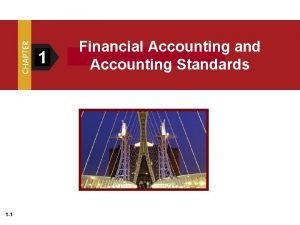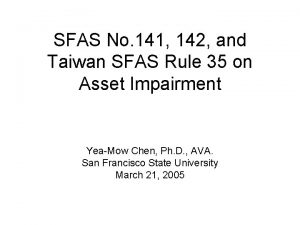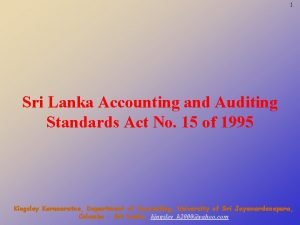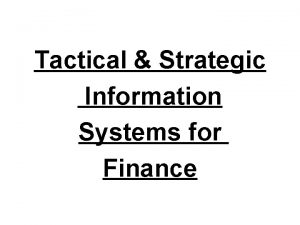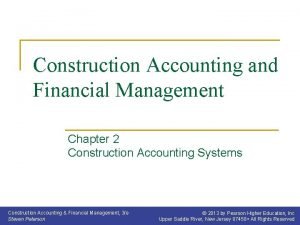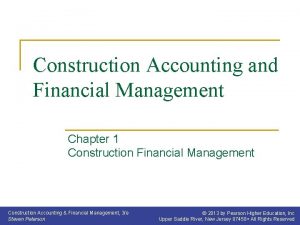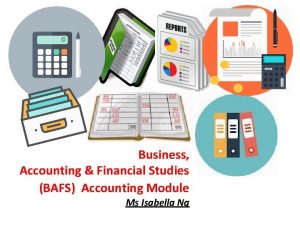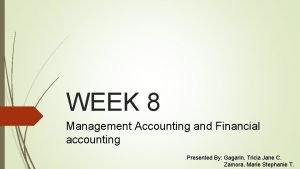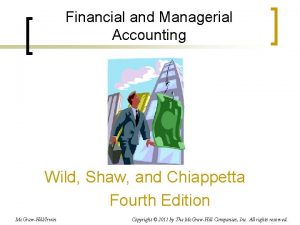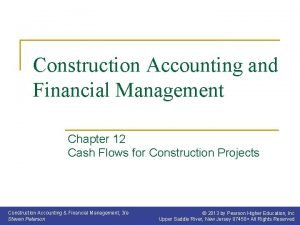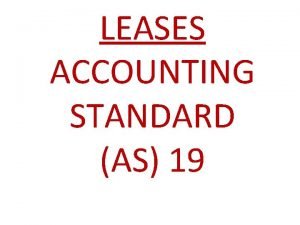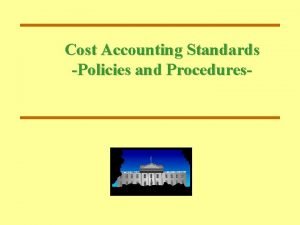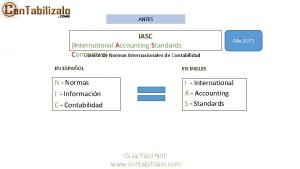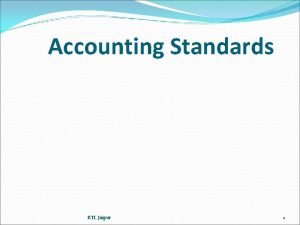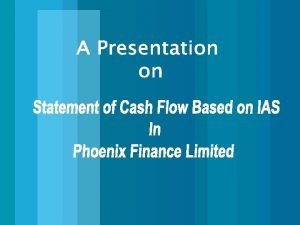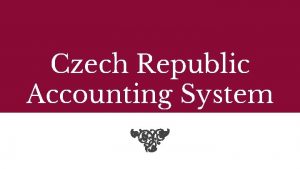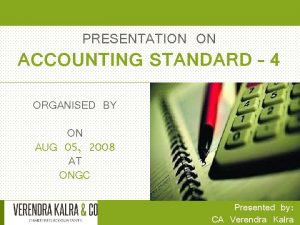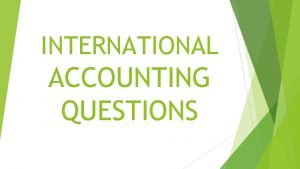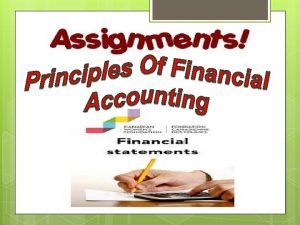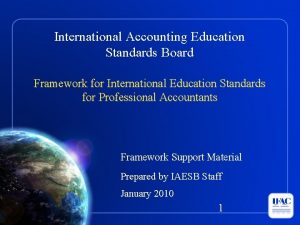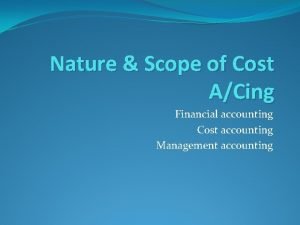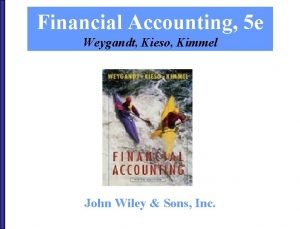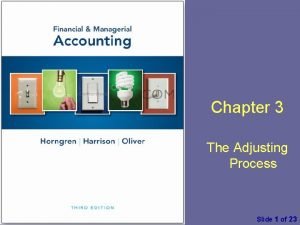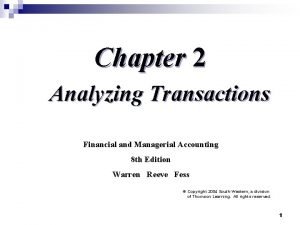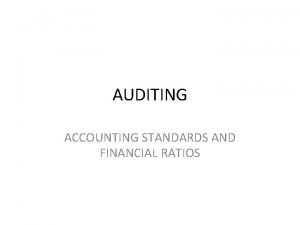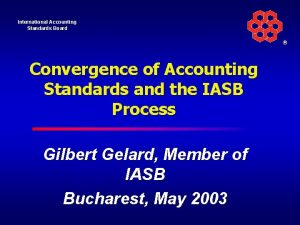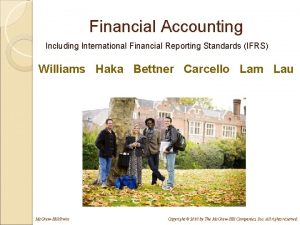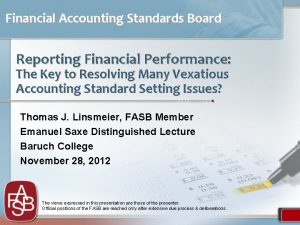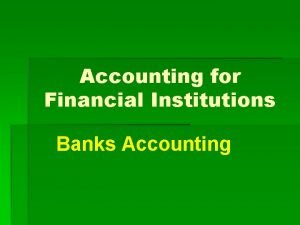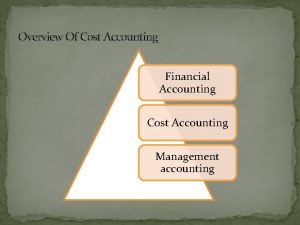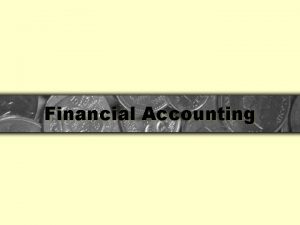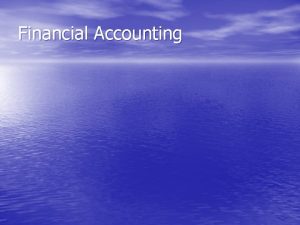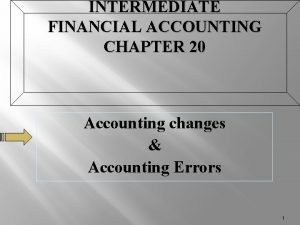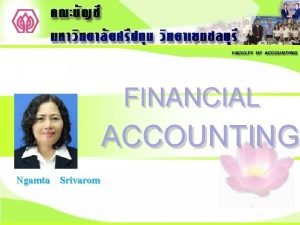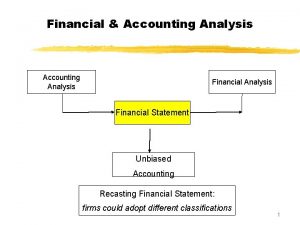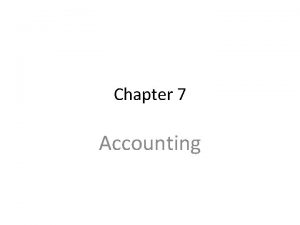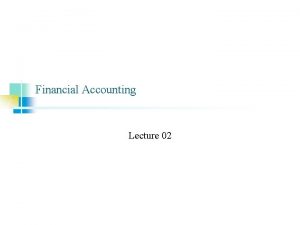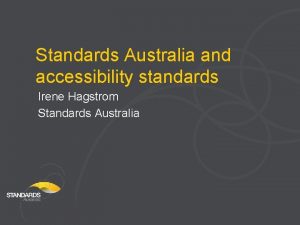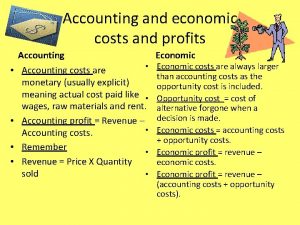1 1 1 Financial Accounting and Accounting Standards







































- Slides: 39

1 1 -1 Financial Accounting and Accounting Standards

Learning Objectives 1 -2 1. Identify the major financial statements and other means of financial reporting. 2. Explain how accounting assists in the efficient use of scarce resources. 3. Identify the objective of financial reporting. 4. Explain the need for accounting standards. 5. Identify the major policy-setting bodies and their role in the standardsetting process. 6. Explain the meaning of generally accepted accounting principles (GAAP) and the role of the Codification for GAAP. 7. Describe the impact of user groups on the rule-making process. 8. Describe some of the challenges facing financial reporting. 9. Understand issues related to ethics and financial accounting.

Financial Accounting and Accounting Standards Financial Statements and Financial Reporting Accounting and capital allocation Objectives Need to develop standards Parties Involved in Standard-Setting Securities and Exchange Commission American Institute of CPAs Financial Accounting Standards Board Changing role of the AICPA 1 -3 Generally Accepted Accounting Principles FASB Codification Issues in Financial Reporting Political environment Expectations gap Financial reporting challenges International accounting standards Ethics

Financial Statements and Financial Reporting Essential characteristics of accounting are: (1) the identification, measurement, and communication of financial information about (2) economic entities to (3) interested parties. 1 -4 LO 1 Identify the major financial statements and other means of financial reporting.

Financial Statements and Financial Reporting Economic Entity Financial Statements Additional Information Financial Information Balance Sheet President’s letter Income Statement Prospectuses Statement of Cash Flows Reports filed with governmental agencies Accounting? Identifies and Measures and Communicates 1 -5 Statement of Owners’ or Stockholders’ Equity News releases Forecasts Note Disclosures Environmental impact statements GAAP Etc. LO 1 Identify the major financial statements and other means of financial reporting.

Financial Statements and Financial Reporting Review Question What is the purpose of information presented in notes to the financial statements? 1 -6 a. To provide disclosure required by generally accepted accounting principles. b. To correct improper presentation in the financial statements. c. To provide recognition of amounts not included in the totals of the financial statements. d. To present management’s responses to auditor comments. LO 1 Identify the major financial statements and other means of financial reporting.

Financial Statements and Financial Reporting Accounting and Capital Allocation Resources are limited. Efficient use of resources often determines whether a business thrives. Illustration 1 -1 Capital Allocation Process 1 -7 LO 2 Explain how accounting assists in the efficient use of scare resources.

Accounting and Capital Allocation Review Question An effective process of capital allocation is critical to a healthy economy, which 1 -8 a. promotes productivity. b. encourages innovation. c. provides an efficient and liquid market for buying and selling securities. d. All of the above. LO 2 Explain how accounting assists in the efficient use of scare resources.

Financial Statements and Financial Reporting Objectives of Financial Reporting Provide financial information about the reporting entity that is useful to u present and potential equity investors, u lenders, and u other creditors in making decisions in their capacity as capital providers. 1 -9 LO 3 Identify the objectives of financial reporting.

Objective of Financial Accounting General-Purpose Financial Statements u Provide financial reporting information to a wide variety of users. u Provide the most useful information possible at the least cost. Equity Investors and Creditors Investors are the primary user group. 1 -10 LO 3 Identify the objectives of financial reporting.

Objective of Financial Accounting Entity Perspective Companies viewed as separate and distinct from their owners. Decision-Usefulness Investors are interested in assessing the company’s 1. ability to generate net cash inflows and 2. management’s ability to protect and enhance the capital providers’ investments. 1 -11 LO 3 Identify the objectives of financial reporting.

Need to Develop Standards Various users need financial information The accounting profession has attempted to develop a set of standards that are generally accepted and universally practiced. 1 -12 Financial Statements Balance Sheet Income Statement of Stockholders’ Equity Statement of Cash Flows Note Disclosure Generally Accepted Accounting Principles (GAAP) LO 4 Explain the need for accounting standards.

Parties Involved in Standard Setting Three organizations: 1 -13 u Securities and Exchange Commission (SEC). u American Institute of Certified Public Accountants (AICPA). u Financial Accounting Standards Board (FASB). LO 5 Identify the major policy-setting bodies and their role in the standard-setting process.

Parties Involved in Standard Setting Securities and Exchange Commission (SEC) u Established by federal government. u Accounting and reporting for public companies. Securities Act of 1933 1 -14 Securities Act of 1934 http: //www. sec. gov/ u Encouraged private standard-setting body. u SEC requires public companies to adhere to GAAP. u SEC Oversight. u Enforcement Authority. LO 5 Identify the major policy-setting bodies and their role in the standard-setting process.

Parties Involved in Standard Setting American Institute of CPAs (AICPA) u National professional organization u Established the following: http: //www. aicpa. org/ Committee on Accounting Procedures 1939 to 1959 l Issued 51 Accounting Research Bulletins (ARBs) l l 1 -15 Problem-by-problem approach failed Accounting Principles Board 1959 to 1973 l Issued 31 Accounting Principle Board Opinions (APBOs) l l Wheat Committee recommendations adopted in 1973 LO 5

Parties Involved in Standard Setting Financial Accounting Standards Board (FASB) Wheat Committee’s recommendations resulted in creation of FASB. Financial Accounting Foundation Financial Accounting Standards Board Financial Accounting Standards Advisory Council 1 -16 u u u Selects members of the FASB. Funds their activities. Exercises general oversight. u Mission to establish and improve standards of financial accounting and reporting. u Consult on major policy issues. LO 5

Parties Involved in Standard Setting Changing Role of AICPA The AICPA established the Accounting Standards Executive Committee (Ac. SEC): u Audit and Accounting Guides. u Statements of Position (SOP). u Practice Bulletins. AICPA and Ac. SEC no longer issues authoritative accounting guidance for public companies. PCAOB oversees the development of auditing standards. 1 -17 LO 5 Identify the major policy-setting bodies and their role in the standard-setting process.

Generally Accepted Accounting Principles that have substantial authoritative support. Major sources of GAAP: 1 -18 u FASB Standards, Interpretations, and Staff Positions. u APB Opinions. u AICPA Accounting Research Bulletins. LO 6 Explain the meaning of generally accepted accounting principles (GAAP) and the role of the Codification for GAAP.

Generally Accepted Accounting Principles Illustration 1 -4 GAAP Documents 1 -19 LO 6 Explain the meaning of generally accepted accounting principles (GAAP) and the role of the Codification for GAAP.

Generally Accepted Accounting Principles Review Which of the following accounting pronouncements is the most authoritative? 1 -20 a. FASB Statement of Financial Accounting Concepts. b. FASB Technical Bulletins. c. AICPA Accounting Principles Board Opinion. d. AICPA Statement of Position. LO 6 Explain the meaning of generally accepted accounting principles (GAAP) and the role of the Codification for GAAP.

Issues in Financial Reporting GAAP in a Political Environment Illustration 1 -6 User Groups that Influence the Formulation of Accounting Standards GAAP is as much a product of political action as they are of careful logic or empirical findings. 1 -21 LO 7 Describe the impact of user groups on the rule-making process.

Issues in Financial Reporting Expectation GAAP What the public thinks accountants should do vs. what accountants think they can do. 1 -22 u Difficult to close in light of accounting scandals. u Sarbanes-Oxley Act (2002). u Public Company Accounting Oversight Board (PCAOB). LO 7 Describe the impact of user groups on the rule-making process.

Issues in Financial Reporting Challenges 1 -23 u Non-financial measurements. u Forward-looking information. u Soft assets. u Timeliness LO 8 Describe some of the challenges facing financial reporting.

Issues in Financial Reporting International Accounting Standards Two sets of standards accepted for international use: u U. S. GAAP, issued by the FASB. u International Financial Reporting Standards (IFRS), issued by the IASB. FASB and IASB recognize that global markets will best be served if only one set of GAAP is used. 1 -24 LO 8 Describe some of the challenges facing financial reporting.

Issues in Financial Reporting CA 1 -9 (GAAP Terminology): With accounting and finance, it often helps to be fluent in abbreviations and acronyms. Instructions: Presented below is a list of common accounting acronyms. Identify the term for which each acronym stands, and provide a brief definition of each term. 1 -25 (a) AICPA (e) FAF (i) CPA (b) CAP (f) FASAC (j) FASB (c) ARB (g) SOP (k) SEC (d) APB (h) GAAP (l) IASB LO 8 Describe some of the challenges facing financial reporting.

Issues in Financial Reporting Ethics in the Environment of Financial Accounting In accounting, we frequently encounter ethical dilemmas. 1 -26 u GAAP does not always provide an answer. u Doing the right thing is not always easy or obvious. LO 9 Understand issues related to ethics and financial accounting.

International Standard-Setting Organizations: International Accounting Standards Board (IASB) 1 -27 u Issues International Financial Reporting Standards (IFRS). u Standards used on most foreign exchanges. u Standards used by foreign companies listing on U. S. securities exchanges. u IFRS used in over 115 countries.

International Organization of Securities Commissions (IOSCO) u Does not set accounting standards. u Dedicated to ensuring that global markets can operate in an efficient and effective basis. http: //www. iosco. org/ 1 -28

International Accounting Standards Board (IASB) Composed of four organizations— 1 -29 u International Accounting Standards Committee Foundation (IASCF). u International Accounting Standards Board (IASB). u Standards Advisory Council. u International Financial Reporting Interpretations Committee (IFRIC). http: //www. iasb. org

Illustration IFRS 1 -2 International Standard-Setting Structure 1 -30

Review Question IFRS stands for: a. International Federation of Reporting Services. b. Independent Financial Reporting Standards. c. International Financial Reporting Standards. d. Integrated Financial Reporting Services. 1 -31

Review Question The major key players on the international side are the: a. IASB and FASB. b. SEC and FASB. c. IOSCO and the SEC. d. IASB and IOSCO. 1 -32

Review Question Which body from the U. S. side is similar to the IASB? a. SEC. b. FASB. c. FASC. d. FAF. 1 -33

Types of Pronouncements 1 -34 u International Financial Reporting Standards. u Framework for financial reporting. u International financial reporting interpretations.

Hierarchy of IFRS Companies first look to: 1. International Financial Reporting Standards; 2. International Accounting Standards; and 3. Interpretations originated by the International Financial Reporting Interpretations Committee (IFRIC) or the former Standing Interpretations Committee (SIC). 1 -35

Review Question IFRS is comprised of: a. International Financial Reporting Standards and FASB financial reporting standards. b. International Financial Reporting Standards, International Accounting Standards, and international accounting interpretations. c. International Accounting Standards and international accounting interpretations. d. FASB financial reporting standards and International Accounting Standards. 1 -36

International Convergence The SEC appears committed to move to IFRS, assuming that certain conditions are met. Illustration IFRS 1 -3 SEC Roadmap 1 -37

International Convergence The SEC will decide, sometime in 2011, whether to mandate the use of IFRS. It is likely that not all companies would be required immediately to change to IFRS, but there would be a transition period in which this would be accomplished. 1 -38

End of Session 2 1 -39
 Financial accounting and accounting standards chapter 1
Financial accounting and accounting standards chapter 1 The major key players on the international side are the
The major key players on the international side are the Fasb 142
Fasb 142 Investment center
Investment center Factors necessary for service standards are
Factors necessary for service standards are Non-financial motivators
Non-financial motivators Worldwide accounting diversity and international standards
Worldwide accounting diversity and international standards Accounting standards act
Accounting standards act International financial reporting standards 9
International financial reporting standards 9 Tactical information systems
Tactical information systems Construction accounting basics
Construction accounting basics Unit 13 accounting and financial statements
Unit 13 accounting and financial statements Cost of goods manufactured formula
Cost of goods manufactured formula Construction accounting and financial management
Construction accounting and financial management Business accounting and financial studies
Business accounting and financial studies External users of accounting information
External users of accounting information Wild financial and managerial accounting
Wild financial and managerial accounting Construction accounting and financial management
Construction accounting and financial management Local accounting standards
Local accounting standards As 19 accounting standards
As 19 accounting standards German accounting standards
German accounting standards Cost accounting standards
Cost accounting standards Contabilizalo
Contabilizalo Rti jaipur
Rti jaipur Meaning of accounting standard
Meaning of accounting standard International accounting standards ias
International accounting standards ias Czech accounting standards
Czech accounting standards Accounting standard 4
Accounting standard 4 International accounting questions and answers
International accounting questions and answers Accounting standard 29 pdf
Accounting standard 29 pdf What are the accounting concepts and conventions
What are the accounting concepts and conventions International accounting education standards board
International accounting education standards board Current cash debt coverage ratio
Current cash debt coverage ratio Scop of management accounting
Scop of management accounting Scope of financial accounting
Scope of financial accounting Nature management accounting
Nature management accounting Kimmel accounting tools 5e
Kimmel accounting tools 5e Income statement in financial accounting
Income statement in financial accounting Financial accounting chapter 2 solutions
Financial accounting chapter 2 solutions Unit 5 lesson 2 financial accounting
Unit 5 lesson 2 financial accounting

